Overview
Within This Page
Parking as part of an overall transportation system is one of the crucial issues of our times. As the number of automobiles increases exponentially around the world, the need to house them in close proximity to destinations creates a challenging design problem. The parking facility or lot must foremost deal with the Functional/Operational—as in providing for safe and efficient passage of the automobile and driver. This is a very complex challenge as automotive, engineering and traffic issues relative to site locations must be integrated to create the appropriate solution. Therefore designing the parking facility requires an integrated design approach of many professionals. Parking has often been reduced to the construction of the most minimal stand-alone structure or parking lot without human, aesthetic or integrative considerations. This has given parking a poor public perception and has frequently disrupted existing urban fabric. However, many architects, engineers, and planners have envisioned and constructed far more complex, aesthetic, and integrative structures. This should be the goal of good parking design.
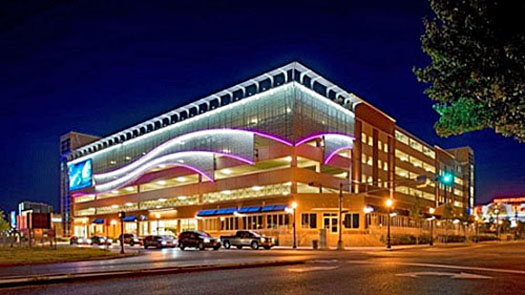
The Wave Mixed-Use Facility, a part of the Atlantic City redevelopment effort, Atlantic City, NJ
Photo provided by Timothy Haahs and Associates
Building Attributes
Although parking facilities can take many forms as stand-alone or part of a mixed-use structure, self-park or valet, and automated in urban settings, all parking facilities should seek to meet the following basic criteria:
Planning
Planning for parking facilities is a complex activity that requires the collaboration of many professionals for a successful outcome. Planning for the integration of parking in the urban environment must first start with the consideration of site. Transit Villages, Smart Growth and New Urbanist planning strategies are becoming popular and are being built in greater frequency around the county. They each address the movement and storage of cars in various ways that combine residential use with many other building types and other forms of transportation.
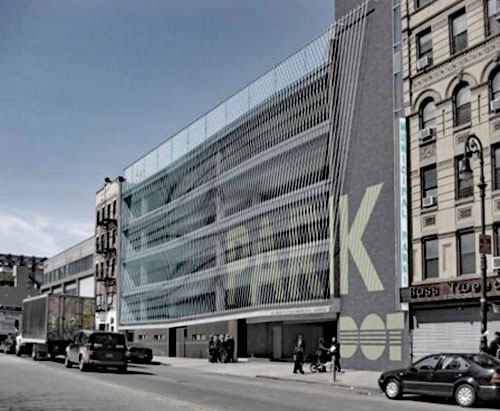
The Delancey Garage
Michielli + Wyetzner Architects
Functional Requirements
The facility should account for the complex spatial needs of the driver and the automobile:
- The size, height, and turning radius of current automobiles as well as past and future trends of automobile size and statistical quantity must be taken into account these are called parking geometries.
- There are many ramp design configurations and different ones are appropriate for the primary purpose of the facility to insure that your intended use is compatible with ramp design.
- The streets surrounding the facility and their traffic flow must be taken into consideration when planning entrances and exits and deciding on ramp designs.
- The entrances and exits are very important to the smooth functioning of the facility, with the type of use again determining the length from the opening and placement of the entry booths, as well as the quantity of entrances and exits.
- The type of equipment and the necessity of a booth and office are also determined by the facility use.
- Zoning issues require the number of spaces for parked automobiles. The designer must work within local codes to meet these requirements.
- In mixed-use projects there has been shared parking documenting how different users can maintain full facility occupancy, such as movie/theater goers, night use and residential use during the day. This can be calculated to the advantage of the facility owner and the community by eliminating the empty night facility syndrome.
- Optimizing site potential, by choice of site and its relationship to walking, driving, other transportation linkages and good design opportunities.
- The operation and maintenance of a facility is very critical. Revenue control equipment and other issues related to the smooth functioning of the garage must be taken into account during the design process.
- Provide for appropriate work space for the staff, such as cashier and monitoring equipment.
- Provide an area or room for the storage and maintenance issues. This area should be heated/air-conditioned and contain a mop sink.
- Accommodate technological tools for future upgrades of operational systems and facility expansion.
- Plan for a back up power system.
- Ventilation is an issue within some types and some areas of parking facility design. New technologies are increasing the effectiveness in design and monitoring of these areas for concern. Natural ventilation is always a good method however detailed study is required in some areas and types of parking facility design to determine its effectiveness.
- Lighting is a crucial aspect of parking and type, placement, and quantity needs to be carefully studied to provide enough light for the users of the parking garage and not to spill out of the parking facility affecting surroundings.
Structural Integration
The efficient integration of structure is crucial to maximum functioning of the facility:
- The parking facility is typically an exposed structure and must be designed to withstand all aspects of environmental conditions.
- There are ideal structural bays that allow for maximum number of parking spaces and flow of automobiles dependent upon site and structure.
- Cast in place concrete, pre-cast concrete and structural steel can be used for the structural design.
- Typical construction issues such as natural hazards in the location of construction apply and compound the solutions in designing a structure that is completely exposed to the weather and constant movement from automobiles.
- Size and length of some structures compound the expansion and contraction issues already of key importance in facility design.
- The surface of the "floor" of the facility is important to slippage issues as one must always design a facility as a fully exposed building for the safe use by both the automobile and pedestrian.
- In very cold climates ice, snow, salt and other road chemicals must be taken into consideration. Some facilities have snow chutes where snow can be plowed off of the top level of the structure. At minimum an area where snow can be piled must be designed into the structure or lot.
- Drainage and floor slope is very important, as ponding water can create long term maintenance problems.
- Peer review of the design is often used on facility documents before the construction process. Performance objectives, cost-effectiveness, and building commissioning are useful tools.
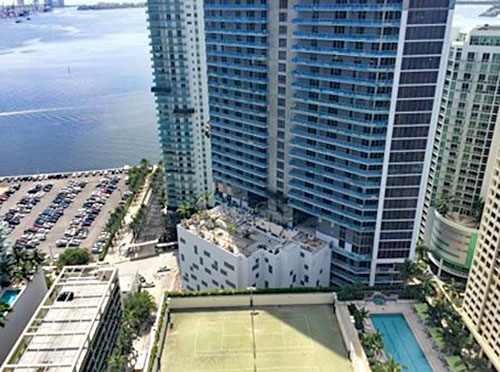
Looking up at the 13–level 480–car RoboticValet™ garage at the Brickellhouse condominium in Miami, Florida.
Photo Credit: Michael J. Paddon / Woody Nash, Boomerang Systems, Inc.
Operations and Maintenance
One of the important aspects of parking facilities is their operations and maintenance. The constant use of parking facilities as an expected part of our infrastructure and as revenue generating requires unique maintenance and operational needs. Maintenance is crucial due to its complete exposure to the weather.
Maintenance requires a specific program and checklist and the frequency for maintenance (recommended and minimum). This list covers cleaning, doors and hardware, electrical, elevators, HVAC, landscaping, painting, parking control equipment, plumbing, drainage, and roofing, safety, security, signs and graphics, structural systems and waterproofing.
The long-term maintenance of the concrete especially in freeze/thaw conditions is especially important. Expansion and control joints are also an important part of this maintenance. Lighting maintenance and control for the safety of the users is also crucial.
Operations:
- Operating a parking facility requires interaction with the general public and many legal rules and regulations.
- Financing, revenue and costs are critical to its functioning as a building type.
- Employee training and proper auditing processes are vital.
- No longer a cash only process, the parking facility now embraces many forms of payment and different types of payment systems such as pay on foot.
- Often, it is owned and operated by a municipality or another entity such as an airport and all of the interrelationships and requirements between these building types and owners must be addressed.
- Transportation Demand Management is linked to parking facilities as well as traffic engineering.
Safety and Security
Safety and security of the people using the facility are of paramount importance:
- Open, glass stairwells and glass-backed elevators.
- Security devices such as video, audio and emergency buttons that call into the booth or local police station.
- Eliminate potential hiding places, such as under open stairs.
- Handicap accessibility with vehicles close to stair and elevator cores having a direct path to key movement patterns of the facility.
- To avoid carbon monoxide build-up, air flow is adequately designed for through mechanical and/or natural ventilation.
- Non-slip floor surface
- Cleanliness
- Design for the points of intersection between man and the automobile for adequate safety of movement.
- Energy efficient lighting is very important in facility safety but can pose problems with spillage out of the facility onto neighboring communities. A balance between daylighting, interior lighting and exterior control can be addressed in many ways on the exterior design of the façade while providing adequate lighting within. Lights should be vandal resistant and easy to maintain.
- Use CPTED (Crime Prevention Through Environmental Design) whenever appropriate along with technological equipment. For more information, see WBSG Landscape Architecture and the Site Security Design Process)
- Life safety is of key importance in any built structure and the parking garage is no exception.
Signs and Wayfinding
- Color-coding, numbering, visual cues, music, and even machines for marking your ticket with your exact location to locate your car for easy retrieval
- Locate signs in areas where driver can read in a timely fashion.
- Clear, simple, and direct messages.
- Floor coding can be useful
- Signage should locate all major internal pedestrian access points as well as external major roads and buildings.
- Art has been used to assist with wayfinding as well as a way to enliven our everyday experience.
Aesthetics
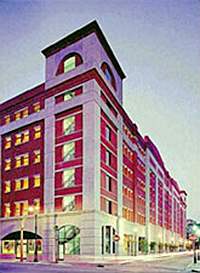
Bryan Street Garage
Photo Credit: Carl Walker, Inc.
Aesthetics of facility design has become very important to communities across the country:
- Recently facility design has become part of an architectural style of the surrounding architecture, respecting the language of design and using the design process.
- The historic preservation movement was one of the key issues in facility design as facilities were needed to revitalize dense older urban fabrics without destroying the architectural context. Many excellent examples can be found across the country solving these contextual issues.
- The Parking facility itself is now also part of the historic preservation movement as some older existing structures can and should be designated for preservation.
- The Parking Facility has played an important role in design evolution throughout its history often being the leader in many crucial design issues; it is truly a unique and important civic building. Perhaps one of the most important design laboratories of the 20th century it has become the gateway to our buildings and cities.
- Maintain the urban street front by having the sidewalk condition of the facility contain stores or provide a safe and pleasant walk experience.
- Using landscaping and changes in architectural materials, forms, and scales to enhance the facility façade along the street. Use landscaping to shield and enhance parking lot design.
- Architecturally breaking down the scale of the large structure along its façade.
- Designing beautiful stairs and elevator cores to enhance the community and walking experience.
- Most costly solution is to "hide" the facility by placing below ground.
Integrated and Mixed-Use Design
Facilities are often connected to other uses and building types.
- The facility has always been a mixed-use structure combining and often connected with all other building types.
- Plan for any loading or unloading conditions required by mixed-use, so as not to interfere with facility traffic.
- Separate roofing and structural system for any human-occupied space within facility.
- Provide for simple and well-designed movement systems for pedestrian and automobiles.
- Many facilities are combined with almost any use imaginable such as a playing surface on the roof requiring green architecture, so enjoy the possibilities of integrating a fully functional structure requiring many technological advances.
- Surface parking lots can be designed to become mixed-use plaza spaces.
- The facility has often in its history been part of a multi-modal system linking different forms of transportation.
Environmental Issues
The car in its early years was the environmental savior of our cities and towns, eliminating animal waste and carcasses in our streets, part of the cause of many health and environmental hazards at the beginning of the century. But as their numbers and use have dramatically increased they have become part of the current environmental problems.
Air Pollution
New fuel sources for the automobile can eliminate air pollution hazards caused by emissions from the vehicle and automobile manufacturers are working on several solutions. Electric vehicles are becoming more available and popular emitting no pollution while driving.
Energy
Parking facilities as large areas of paved surfaces contribute to warming trends in cities and can alter local weather patterns. The addition of solar panels sometimes simultaneously serving as shading devices or aesthetic façade treatments can work to address multiple concerns. Wind turbines on the roof can also assist with energy generation.
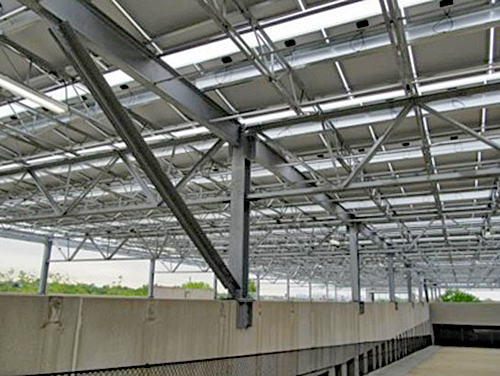
The Bergen County Solar Parking Garage Canopy is a solar powered parking facility.
Photo Credit: Stantec
Water
Local codes can assist with addressing the amount of parking allowed. Paving that has absorbed oils, fuels, road salts and other materials contribute to problems in water runoff and water pollution. As well, pervious paving can provide a solution in parking lots.
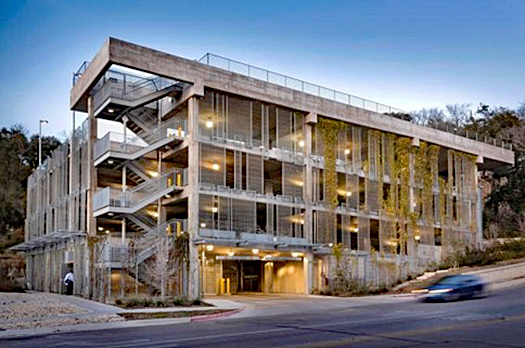
T3 Parking Structure has transparency, light from a light well within, and a green roof as part of its appeal in a residential neighborhood.
Photo Credit: Whit Preston, photographer and Danze Blood Architects PLLC
Green Globes, Energy Star and even LEED are recognizing parking as part of a sustainable rating system. Parksmart has developed specific criteria for sustainable garages.
Sustainable Designs
This term discusses a set of interrelated issues that is very complex when applied to the parking facility typology. The parking facility in and of itself is a better land-use choice in attempting to create a more sustainable built environment by increasing the amount of parking within a limited land area or making the connection to other forms of transportation reducing traffic and congestion issues. The actual construction of the facility can meet the LEED (Leadership in Energy and Environmental Design) Green Building Rating System® criteria, also refer to WBDG Sustainable Design Objectives. Green Building Rating System criteria and several LEED certified parking facilities are now exist. Advanced material choices both in steel and concrete can contribute to the overall score while site sensitivity is also crucial. Lighting can be handled from both a passive design approach as well as technological solutions to just provide light when needed.
Water conservation, sun control shading and other passive devices can be integrated into parking facilities. Solar and wind technology can also be used to handle energy needs. Also since the parking facility is such an integrative building typology many other solutions can contribute to sustainable design such as the now common for underground parking facilities; the green roof. Due to its integrative nature with other building typologies it can also help to support them in sustainable solutions designing the parking facility to become part of an energy generating solution. The parking facility has often been at the forefront of design advancements due to its ability to be transformed both inside and outside to meet changing practical needs. As the automobile and our energy sources change over the next century, a symbiotic relationship between the building, the automobile, and energy can occur, each providing energy and power to each other creating a totally sustainable solution. The Sands Parking Garage is a free-standing facility without any spaces for human occupation. It integrates many sustainable practices such as: two 10,000 gallon cisterns that collect rainwater for landscaping, overhead canopies that use plants to provide shade on the roof, low-power LED lights, and soon to be installed solar panels. It soon will have charging stations for electric-hybrid cars and is part of the University's overall commitment to a Climate Action Plan for the entire campus.
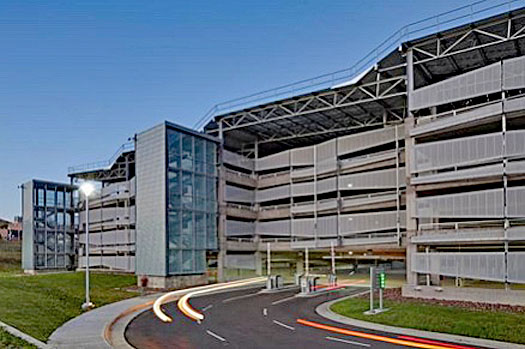
NREL garage at the US Department of Energy Laboratory includes a state of the art solar array. It is exposed structural and architectural steel including a center light well for natural daylighting.
Frank Ooms photographer, Courtesy of RNL Design
Green Roofs
Parking facilities can address sustainable issues in several ways, one being the green roof. The parking garage can also meet the standards of a living, regenerative, and adaptive building. Green Globes, Energy Star, LEED and the Living Building Challenge are recognizing parking as part of a sustainable rating system. Parksmart has developed specific criteria for sustainable garages.
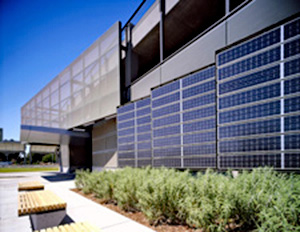
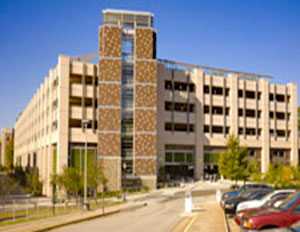
T3 Parking Structure has transparency, light from a light well within, and a green roof as part of its appeal in a residential neighborhood.
Photo Credit: Whit Preston, photographer and Danze Blood Architects PLLC
Sands Parking Garage at Duke University
Photo Credit: ©Vince Streano, 2010
Emerging Issues
Transportation
Parking facilities can serve an important role as a point of passage for the driver from the car to other forms of transportation due to their typical use as the first and last mile part of travel. This gateway role is often overlooked in the design process. In attempting to resolve the complex urban and environmental issues surrounding the use of the automobile in the United States, the parking facility can be seen as part of the solution for the integration of different transportation systems as a gateway or transfer point between systems, bus, train or air. These solutions are not historically new but are seeing a reemergence, as traffic in many urban areas becomes overwhelming and extremely time consuming.
Mixed Use
Parking facilities can also combine with other building types as mixed-use structures due to their very function. Aesthetically pleasing designs as well as land use, safety and ease of use can be better accommodated with a mixed-use structure. Residential and Hospital use/facility combinations typically pose the most difficult design challenges due to fire code issues. An important emerging issue is addressing fire codes as related to mixed use when combining buildings with modern facilities. Transit Villages, Smart Growth, and New Urbanist planning strategies are popular and being built in greater frequency around the county. They each address the movement and storage of cars in various ways that combine residential use with many other building types.
Safety
An emerging issue with safety is a threat/vulnerability assessment in response to car bombings. Risk, cost, and convenience must be factored in together in determining solutions. In certain mixed-use conditions all of these factors should be considered in determining the most appropriate solutions. Technology may eventually play a role in the screening of vehicles for explosives as they enter the parking facility.
Pedestrian Access
Although safety for the pedestrian has been a recent concern in parking facility design with adequate lighting and open stairwell and elevator design, the actual movement of the pedestrian through the facility has rarely been considered. Several facilities are being designed to create a more pleasing environment with separate paths for the pedestrian from their cars to other circulation paths to specific points of destination. Vertical openings piercing the facility and landscape plantings within the structure are also creating a more open, safe, and inviting place to walk. By addressing the pedestrian within the facility they can become a part of a total urban design system addressing our aging society and the important gateway issues of this type.
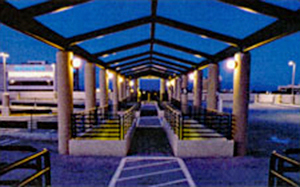
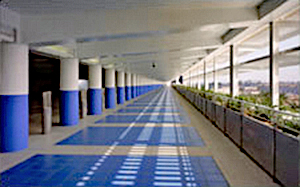
San Mateo Government Center Parking Structure
Photo Credit: Watry Design, Inc.
Disney Resort Guest Parking Structure, Anaheim, California
Photo Credit: © Disney
Technological Changes
Advances in technology are changing the way we can enter and leave a facility. Technological advances in pay systems and movement access systems allow for easier flow of movement of pedestrians and automobiles. Two are AVI — Automatic Vehicle Identification systems and LPR — License Plate Recognition Systems. There are also automated systems that direct your car to the open spaces available and pay-on-foot systems eliminating the booth. Mobile connections now occur, so that your time of arrival to the facility is anticipated and your car is ready for you to drive, fees already paid for. Technological advances are also changing the way and where we work. With many people telecommuting from home the parking facility could be retrofitted to provide the mixed use of small office locations to connect to a main office location downtown.
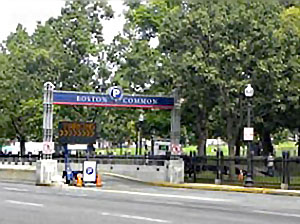
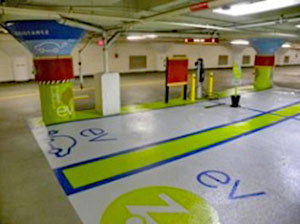
Boston Common Garage Authority is under the park and provides EV charging stations, zipcar sharing (zipcar and hybrid vehicles have priority spaces), AVI readers, and so much more!
Photo Credit: Massachusetts Convention Center Authority
Automated Mechanical Facilities
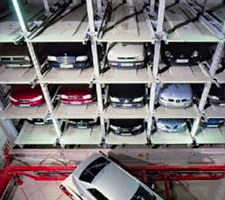
Summit Grand Parc
Photo Credit: Space Saver Parking Company and Mid-American Elevator Company
In the United States there is a long history of mechanical facilities. Starting in the 1920's and again in the 1950's mechanical facility systems were built in this country. Honolulu, Hawaii built systems in the 70's and 80's. Many automated systems have been built across the country typically in dense locations where the project and the site required an automated facility in order for the project to be a success. This type of facility is now competitively priced in most locations, however certain site and/or building type relationships allow this type of facility to be even more economically feasible. Automated facilities have many aspects that reduce cost as they require less lighting and ventilation since they have minimal human use.
There are many other advantages such as more cars per site area, no pedestrian access to the facility and few attendants. Many structural and functional types of automated mechanical systems exist: such as underground systems as part of the building foundation or above grade where they can match neighboring buildings in architectural appearance. The actual mechanisms and movement systems that carry the automobile vary with each manufacturer.
Car stackers, stand-alone systems, have been frequently used in New York City to expand the parking capacity of parking lots. They are now also found within parking garages to expand the capacity of a parking facility. Automated facilities are increasing and becoming accepted in the United States.
Car Sharing
One idea that is taking hold is the idea of point to point use of the car. You would rent the car from home to work where it would be left in a facility to be rented by someone who can use the car during the day. The return trip home would function in the same way. Depending upon the access of these parking rental structures many point to point uses could occur. The Center for Neighborhood Technology can offer insights into many alternative approaches. Uber and Lyft are now operating in many parts of the country providing another mobility option that could minimize the use of the private car and the use of a parking garage in some locations.
Electric Vehicles
The very first parking facilities in the early 1900's were for electric vehicles and charging stations were designed within the facility structure. With the current changes in vehicle design, the parking facility often accommodates electric vehicle use for personal automobiles as well as for campus and other vehicles required for particular owners and users of facilities. The way that a car is powered in the future will solve environmental issues but traffic and parking concerns will remain if we as a culture continue to depend on the single occupancy vehicle. But, as the fuel source changes, the design of the car will also evolve and the way it moves through space will change with it. These design changes will have the power to modify the parking facility/building community relationships. What this means to future architectural design is a place for interesting study and back to the future ideas. New experiments in alternate fuels for vehicles will also impact parking facility design. Smaller city vehicles are now entering the market, and along with the urban planning issues of designing communities as walkable integrating electric vehicles such as MIT CityCar into the transportation mix a safer more accessible environment can be created for all.
New Forms Movement
As the automobile is changing so are new movement technologies appearing that will allow us to move through space in new ways. Personal Rapid Transit (PRT), now known as Automated Transit Networks, although it has been around for over 40 years and is still functioning at West Virginia University in Morgantown is starting to reappear in locations across the world. Heathrow airport opened to the public the most advanced version of PRT in 2011. These small car-like driverless vehicles are traveling point-to-point providing safer, more accessible, faster movement directly to your destination. A new elevator system can travel horizontally as well as vertically allowing for greater use of the elevator shaft and potential to create safer access and egress especially in tall buildings. Driverless vehicles are now emerging and will impact parking in ways that are currently being explored.
These emerging technologies could change the way we design our cities, towns, and buildings to create safer, more environmentally friendly spaces and places due to their scale and ability to interface with alternative sustainable power sources also potentially changing the ground plane.
Bicycle Facilities
The integration of the bicycle as an alternative means of transportation is finding a place in parking facility design, as special places designed for the storage and retrieval of bicycle can easily be accommodated within facility design. In many communities across the country, bicycles are becoming a popular mode of transportation. While areas within facilities are accommodating the safe storage of bicycles and many storage systems exist, the facility itself needs to spatially address the different needs of a bicycle driver. The smaller scale and slower speed of the bicycle, along with concentrated pedestrian traffic requires different spatial relationships and design considerations of separation of man and machine. Separate multi-story and automated bicycle facilities can be found in many places around the United States, starting on the west coast and now Millennium Park in Chicago and Union Station in Washington, D.C.
The Parking Facility a Community Building Type
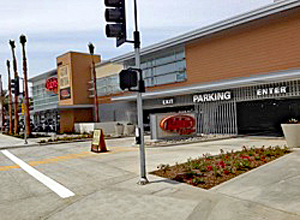
Sherman Oaks grocery store parking.
Photo Credit: David Vogel: Parking Design Group
The Parking Facility has become a community building type that the majority of us use every day. This building type can be designed to address the role that it plays as the entry and exit place to our cities, towns and buildings. As the vehicle continues to change the building type has the opportunity to integrate even more seamlessly into the urban fabric opening up new sustainable opportunities to create community places and spaces.
Aging of the Population—Mobility for All
With the aging of the population the driving habits of Americans' are changing. In order to accommodate these changing needs technology can start to play a part such as with vehicles on smart highways and GIS mapping devices. As well as the changing automobile which can drive and park itself opens up new mobility options for many. These new technologies can also improve mobility, driving and parking for everyone.
Relevant Codes and Standards
The following agencies and organizations have developed codes and standards affecting the design of structured parking. Note that the codes and standards are minimum requirements and local codes can also apply. Architects, engineers, and consultants should consider exceeding the applicable requirements whenever possible:
- GSA PBS-P100 Facilities Standards for the Public Buildings Service
- ICC IBC International Building Code
- Lighting Energy Efficiency in Parking (LEEP) certification: Offered by The US Department of Energy, LEEP enables facility owners and managers to take advantage of savings opportunities from high-efficiency lighting solutions in their parking facilities.
- Parksmart: The Green Parking Council's Green Garage Certification is a way for parking lot owners and operators to back-check their parking structure sustainability.
- Sustainable Sites Certification
- UFGS 32 17 24.00 10 Pavement Markings
- US Access Board: ADA Guidelines: Chapter 5, Accessible Parking Requirements
- US Green Building Council LEED Rating System
Additional Resources
Organizations
- American Planning Association
- American Society of Civil Engineers
- The Automatic and Mechanical Parking Association—A newly formed association to advance the cause of automatic and mechanical facilities.
- Eno Center for Transportation
- Institute of Transportation Engineers
- International Parking Association—An advocacy organization for the parking industry.
- National Parking Association—An advocacy organization for the parking industry.
- National Transportation Research Board
- Parking Today—An advocacy organization for the parking industry.
- Parksmart
- United States Department of Transportation and State and Local Transportation Agencies
- Urban Land Institute
Many related industry organizations such the steel, concrete, construction, engineering, transportation and architecture have their own advocacy organizations and web sites with information on parking facilities issues.
Publications
This is a short list of publications and not at all complete, as this topic has been receiving a great deal of research and interest in the last several years. Please contact all related industry organizations for their most up to date publications for design applications.
- The Aesthetics of Parking by T.P. Smith. Chicago, IL: American Planning Association, 1988.
- The Architecture of Parking by Simon Henley, New York, NY: Thames & Hudson, Inc, 2007.
- The Car in 2035: Mobility Planning for the Near Future by Kati Rubinyi, Ed. New York, NY: Actar, 2013.
- The Dimensions of Parking by the Urban Land Institute and National Parking Association. Washington, D.C.: Urban Land Institute, 2000.
- The High Cost of Free Parking by Donald Shoup, Chicago, IL: American Planning Association, 2017.
- Lots of Parking by John A. Jakle and Keith a. Sculle. Charlottesville, VA: University of Virginia Press, 2004.
- Metropolitan Parking Structures: A Survey of Architectural Problems and Solutions by D. Klose. New York: F.A. Praeger, 1965.
- Open-Deck Steel Framed Parking Structures-A Design Aid by Emile Troup, P.E. and John Cross, P.E. AISC, 2003.
- Parking by Robert Weant and Herbert S. Levinson. Eno Transportation Foundation, 1990.
- Parking by G.H. Baker and B. Funaro. New York: Reinhold, 1958.
- Parking 101: A Parking Primer by Ronald W. Stehman, Ed. Fredericksburg, VA: International Parking Institute, 2001.
- Parking: A Handbook of Environmental Design by J. McCluskey. London: E. & F.N. Spon, 1987.
- The Parking Garage: Design and Evolution of a Modern Urban Form by Shannon S. McDonald. Urban Land Institute, 2007.
- Parking Management Best Practices by Tod Litman. Chicago, IL: APA Planners Press, 2006.
- Parking Management-The Next Level, by Tim Haas, Ed. Fredericksburg, VA, International Parking Institute.
- Parking Reform Made Easy by Richard W. Wilson. Washington DC, Island Press, 2013.
- Parking Selected References Information Packet #327 by the Urban Land Institute. Washington, D.C.: Urban Land Institute, 2000.
- Parking Spaces: A Design, Implementation, and Use Manual for Architects Planners and Engineers by Mark Childs. New York: McGraw Hill, 1999.
- Parking Structures: Planning Design, Construction, Maintenance, and Repair Editor Anthony P. Chrest. Publisher Springer Science & Business Media, 2001.
- Parking: The Parking Handbook for Small Communities by J.D. Edwards. Washington D.C.: Institute for Transportation Engineers; National Main Street Center; National Trust for Historic Preservation, 1994.
- Precast Prestressed Concrete Parking Structures: Recommended Practice for Design and Construction by the PCI committee on Parking Structures, and PCI Committee on Parking Marketing & Promotion. Chicago: Precast/Prestressed Concrete Institute, 1997.
- Reinventing the Automobile: Personal Urban Mobility for the 21st Century by William Mitchell, Chris Borroni-Bird and Lawrence Burns, Boston, MA: MIT Press, 2010.
- Rethinking a Lot: The Design and Culture of Parking by Eran Ben-Joseph, Boston, MA, MIT Press, 2012.
- Sustainable Parking Garage Design and Management: A Practitioners Handbook, National Parking Association and International Parking Institute, 2014.
Others
- Building Research Information Knowledgebase (BRIK)—an interactive portal offering online access to peer-reviewed research projects and case studies in all facets of building, from predesign, design, and construction through occupancy and reuse.
- Parking Network
- Architectural Graphic Standards, 12th Edition by The American Institute of Architects, Dennis J. Hall. New York, NY: John Wiley & Sons, Inc., 2016.
- Green Roofs for Stormwater Runoff Control EPA/600/R-09/026 by the U.S. EPA. Cincinnati, Ohio: EPA, February 2009.
- Guide to FEMP-Designated Parking Structure Lighting by the Federal Energy Management Program. Washington, DC: FEMP, March 2013.
- High-Efficiency Parking Lighting in Federal Facilities Case Study of Camp Pendleton by the U.S. Department of Energy.
- Low Energy Parking Structure Design by the National Renewable Energy Laboratory (NREL). Golden, Colorado: NREL, January 2013.
- Planning and Design Guidelines, Chapter 05—Parking and Loading by City of Surprise, AZ.








